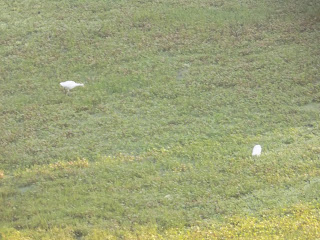Glossy ibis (Plegadis falcinellus) அன்றில் (Threskiornithidae, Pelecaniformes )
The glossy ibis (Plegadis falcinellus) is a water bird in the order of Pelecaniformes and the ibis and spoonbill family Threskiornithidae. The scientific name derives from Ancient Greek plegados and Latin, falcis, both meaning "sickle" and referring to the distinctive shape of the bill.
Glossy ibis was frequently observed near Annakkili Amma Research Institute (AARI) between 1st to 3rd February but later it could only be seen flying through AARI. It was not observed landing near AARI after 3rd February 2021. even though the observation of this ibis here in Feb was frequent it was very rare in march, we could not the exact reason for that.. it is one of the best bird I clicked ever with full of glittering feathers and, it was a little fearless bird so that it allowed me to walk near to take the snap with my SLR camera with less zooming option.
Wetland biodiversity often disturbed by plastics and Thermocol box pieces, here also, they are present in more numbers. The water on this part of the marshland is clear and in good condition, which helps a lot of biodiversities to thrive but the disturbing part is solid wastes.
இது அரிவாள் மூக்கன் குடும்பத்தைச் சார்ந்த ஒரு கரைப்பறவை (shore bird or wader) ஆகும்.
“கூவின பூங்குயில் கூவின கோழி
குருகுகள் இயம்பின இயம்பின சங்கம்
ஓவின தாரகை யொளிஒளி உதயத்து
ஒருப்படுகின்றது…………”
- (ப.திருமுறை: 8: 20: 3)
here kurugu means antril. and also many ancient tamil literature cites different type of Ibis in different names. For example pakantril பகன்றில் (meants white coloured ibis),
வெள்ளை நிற அன்றில் பகன்றில் என அழைக்கப்படும் [பகல் + அன்றில் = பகன்றில்]
திருஞானசம்பந்தர் தமது தேவாரத்தில்
“பகரத்தாரா அன்னம் பகன்றில் பாதம் பணிந்தேத்தத்
தகரப்புன்னை தாழைப் பொழில்சேர் சண்பை நகராரே”
- (ப.திருமுறை: 1: 66: 3)
எனப் பகன்றிலைக் குறிப்பிடுகிறார்.
and red headed ibis was called as senthalai antril (செந்தலை அன்றில்) - (குறுந்தொகை: 160: 1 - 4)
Black legged and black ibis was named as karunkaal antril கருங்கால் அன்றில் (குறுந்தொகை: 301: 1 - 4).
Black legged white ibis was named as "Karunkaal venkurugu" (கருங்கால் வெண்குருகு) - (குறுந்தொகை: 303 :1 - 3).
These names are good examples of the morphological classification system that was well established in the olden Tamil civilization and they are evidently available in Tamil literature.
Ebird Description: Long, curved bill. Adults are mostly dark with iridescent green and reddish tones. The very thin white border surrounding the dark facial skin. Dark eyes. Usually gregarious, it is found mainly in salty marshes and shallow wetlands. Unmistakable in most of its range, though American birds are best distinguished from White-faced Ibis by distribution and facial pattern.


















































